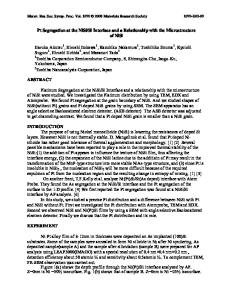Kinetics of agglomeration of NiSi and NiSi 2 phase formation.
- PDF / 135,997 Bytes
- 6 Pages / 612 x 792 pts (letter) Page_size
- 39 Downloads / 357 Views
N4.12.1
Kinetics of agglomeration of NiSi and NiSi2 phase formation. C. Detavernier, A. Özcan, C. Lavoie, Jean-Jordan Sweet, J.M.E. Harper I.B.M. T.J. Watson Research Center, Yorktown Heights, NY.
ABSTRACT We have studied the kinetics of NiSi agglomeration and NiSi2 phase formation during heating of NiSi on Si, using simultaneous in situ measurements of resistance, light scattering and x-ray diffraction. NiSi is a desirable contact to Si because of its low resistivity, limited Si consumption and low formation temperature. However, the formation of the higher resistivity phase NiSi2 must be avoided for device applications. Ni thin films 5 to 30 nm thick were deposited on substrates of poly-Si and silicon-on-insulator (SOI) and were studied using heating rates from 0.3 to 27 oC/s. At low heating rates and for the thinnest films studied, NiSi agglomeration precedes NiSi2 nucleation by as much as 350oC. The agglomeration temperature decreases with decreasing film thickness and linewidth. Once the film is agglomerated, the formation of NiSi2 is delayed to higher temperature by its low nucleation site density and decreased contact area. We conclude that agglomeration is the primary failure mechanism limiting the morphological stability of NiSi as a contact material to Si devices.
INTRODUCTION CoSi2 is currently used for advanced devices, but its sensitivity to oxygen contamination, the considerable Si consumption and the rough CoSi2/Si interface limit its implementation in future generations. NiSi is a possible alternative, which has a lower resistivity (13-15 µΩcm as compared to ~18 µΩcm for CoSi2), consumes less Si and forms through a diffusion controlled reaction, resulting in a smoother interface. However, NiSi also has some significant disadvantages. Firstly, a multitude of metal-rich Ni-silicide phases form at low temperature. Secondly, Ni is known to easily diffuse into Si and act as a deep level trap. The third concern (and main obstacle that has prevented the use of NiSi so far) is the instability of NiSi during high temperature annealing. In this paper, we will report a study of the high temperature stability of NiSi (both regarding agglomeration and NiSi2 nucleation). It will be shown that for relevant film thickness and geometry ( < 30 nm NiSi in narrow lines), agglomeration is the key problem. EXPERIMENTAL Ni films, 5 to 30 nm thick, were deposited onto HF-cleaned (100)-oriented silicon on insulator (SOI) or poly-Si substrates by magnetron sputter deposition. The samples were cleaved into 1cm2 pieces and annealing experiments were performed at the National Synchrotron Light Source (NSLS) X20C beamline at Brookhaven National Laboratory, where we followed in situ the formation of different phases via the development of their characteristic diffraction patterns [1-3]. After multiple evacuations of the vacuum chamber, samples were heated in an ambient of purified He at a rate of 0.3, 1, 3, 9 and 27 °C/s. The temperature measurements were calibrated using metal-silicon eutectics and are precise to ± 3 °C. For t
Data Loading...











